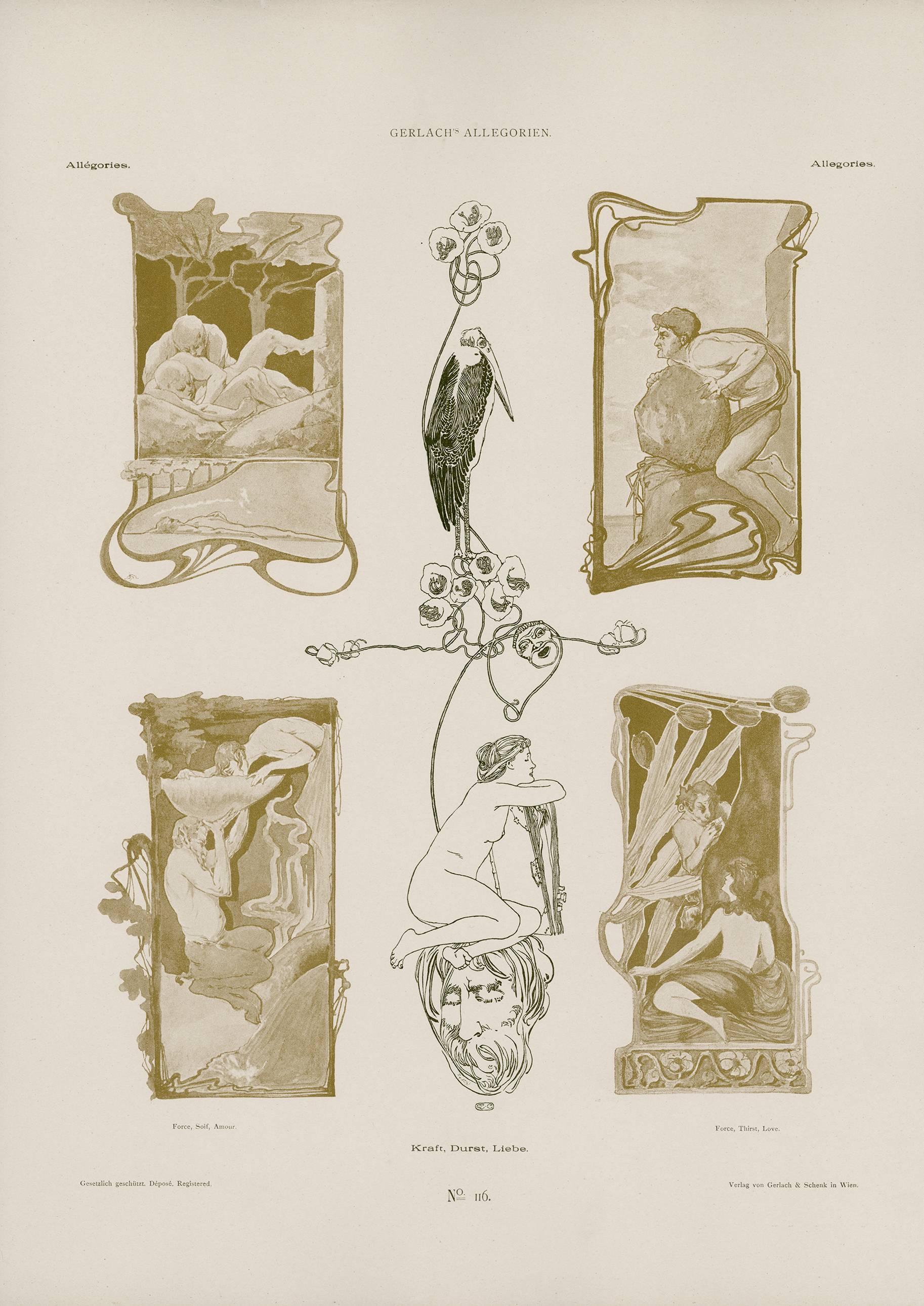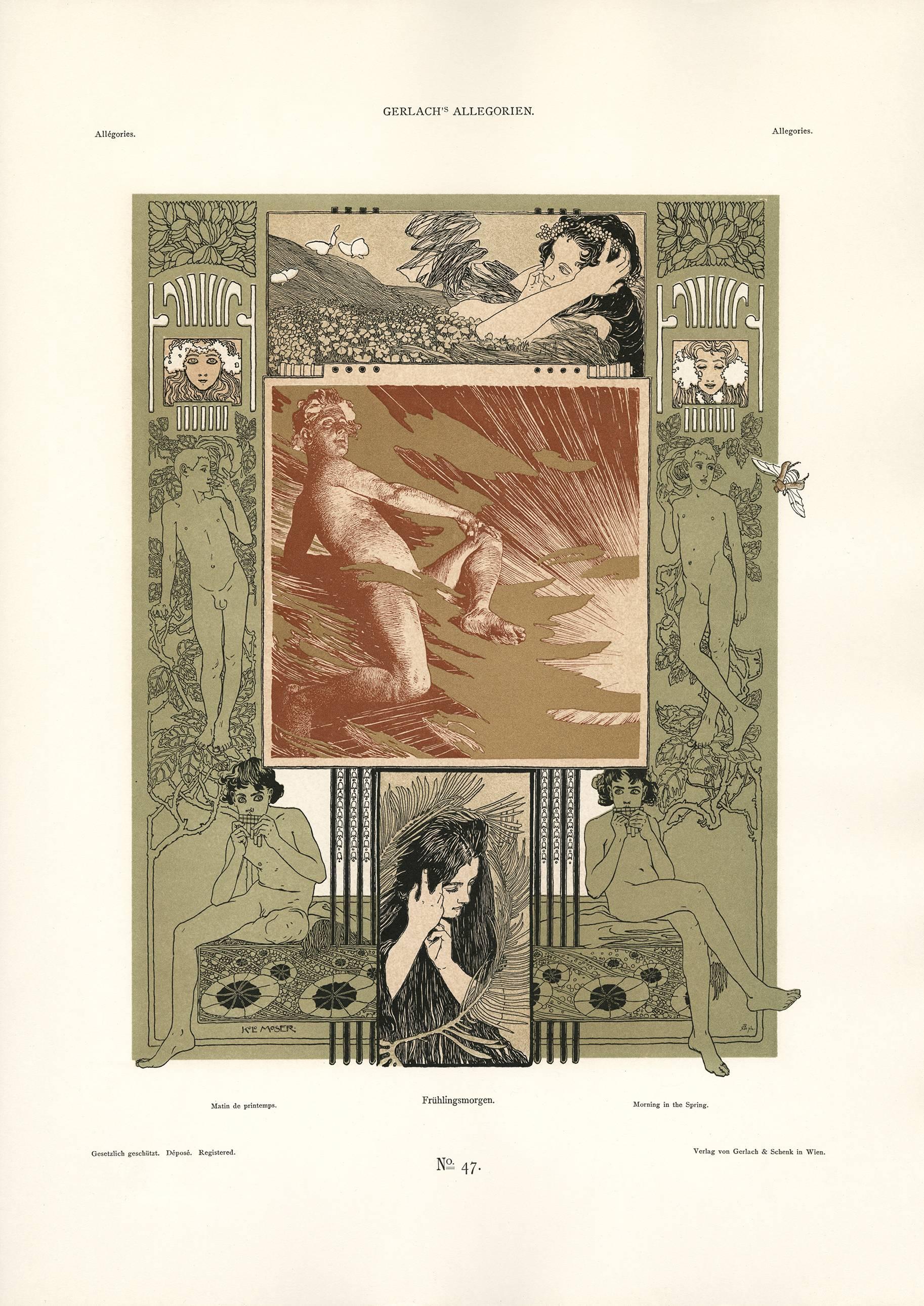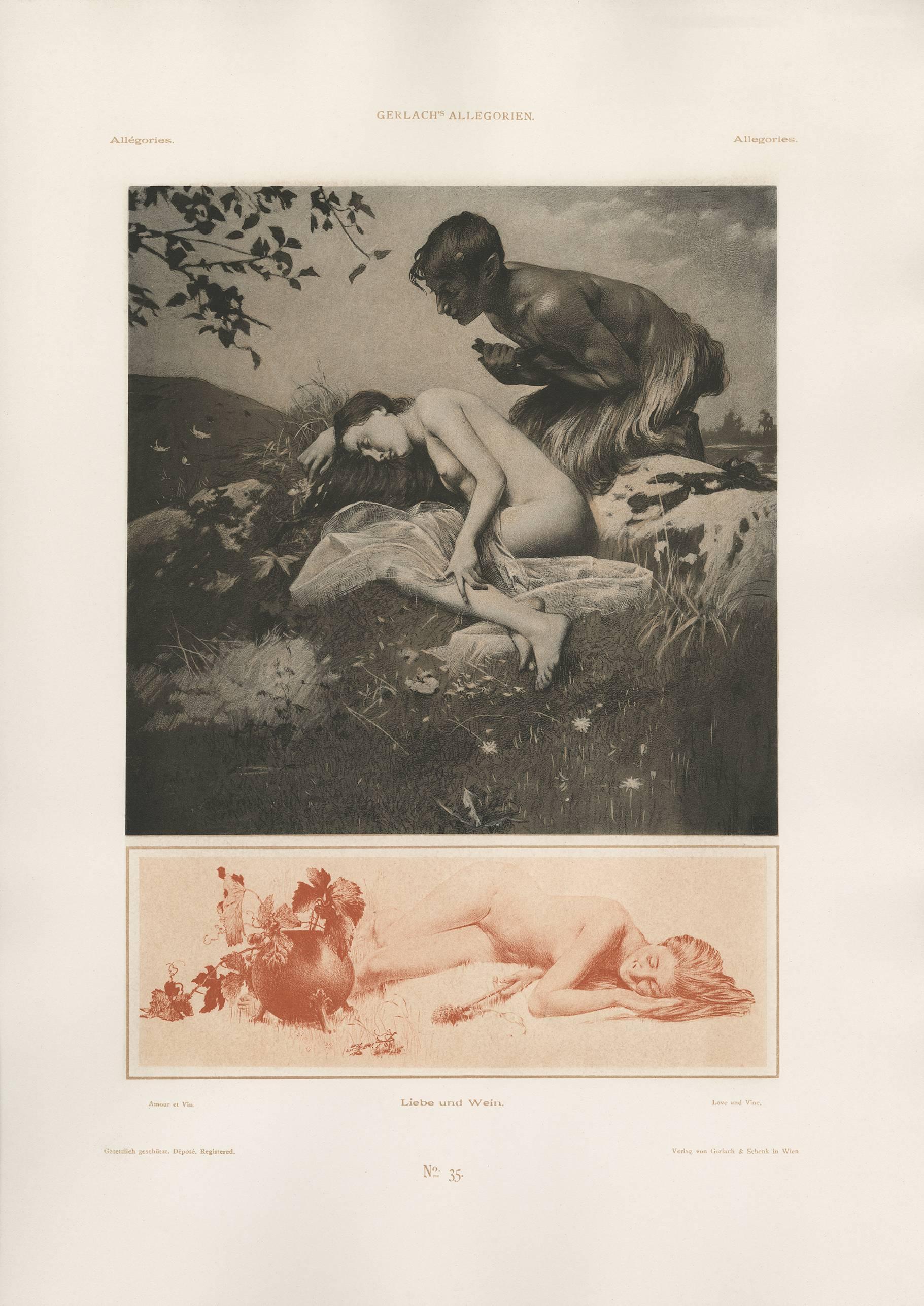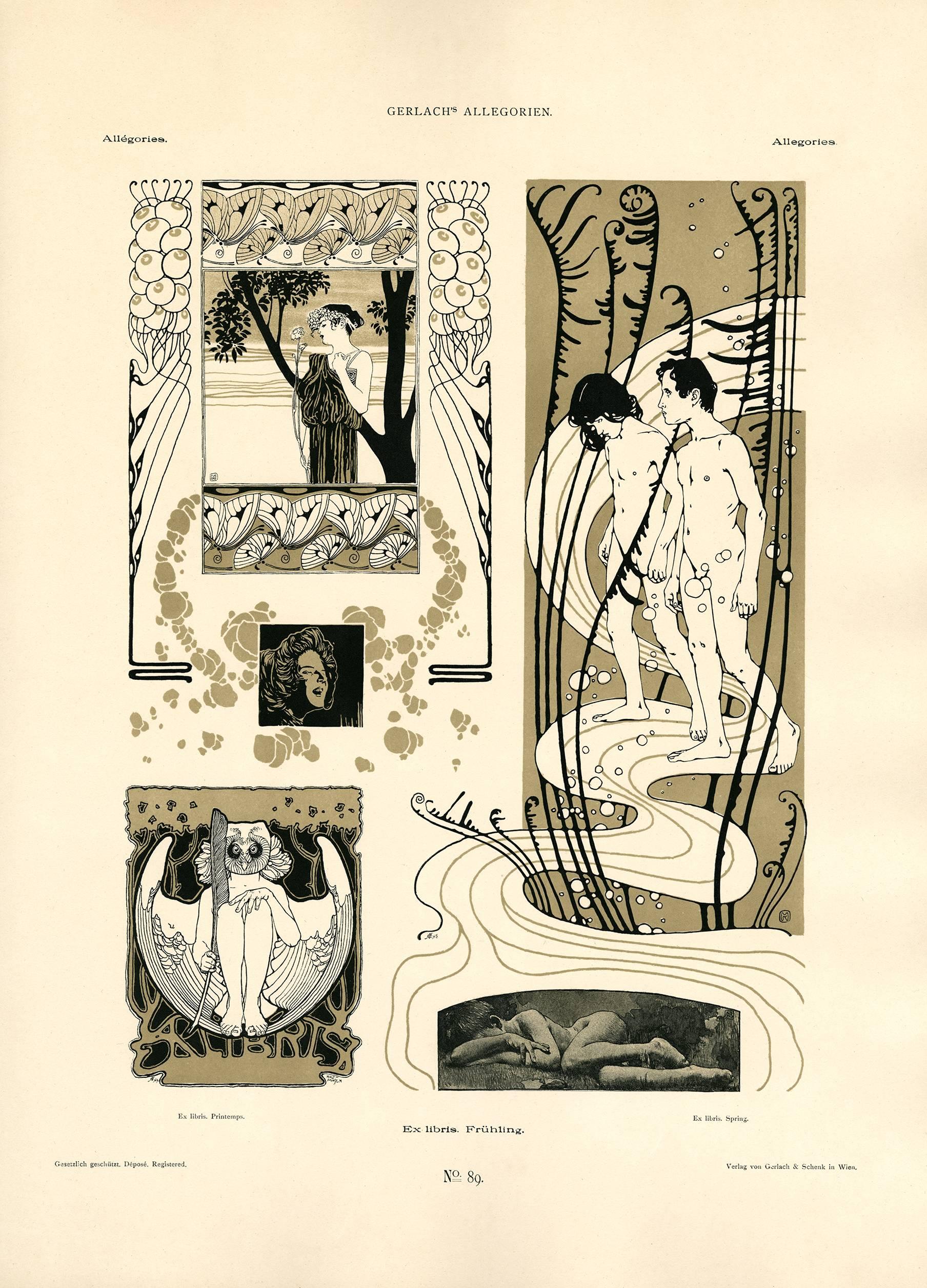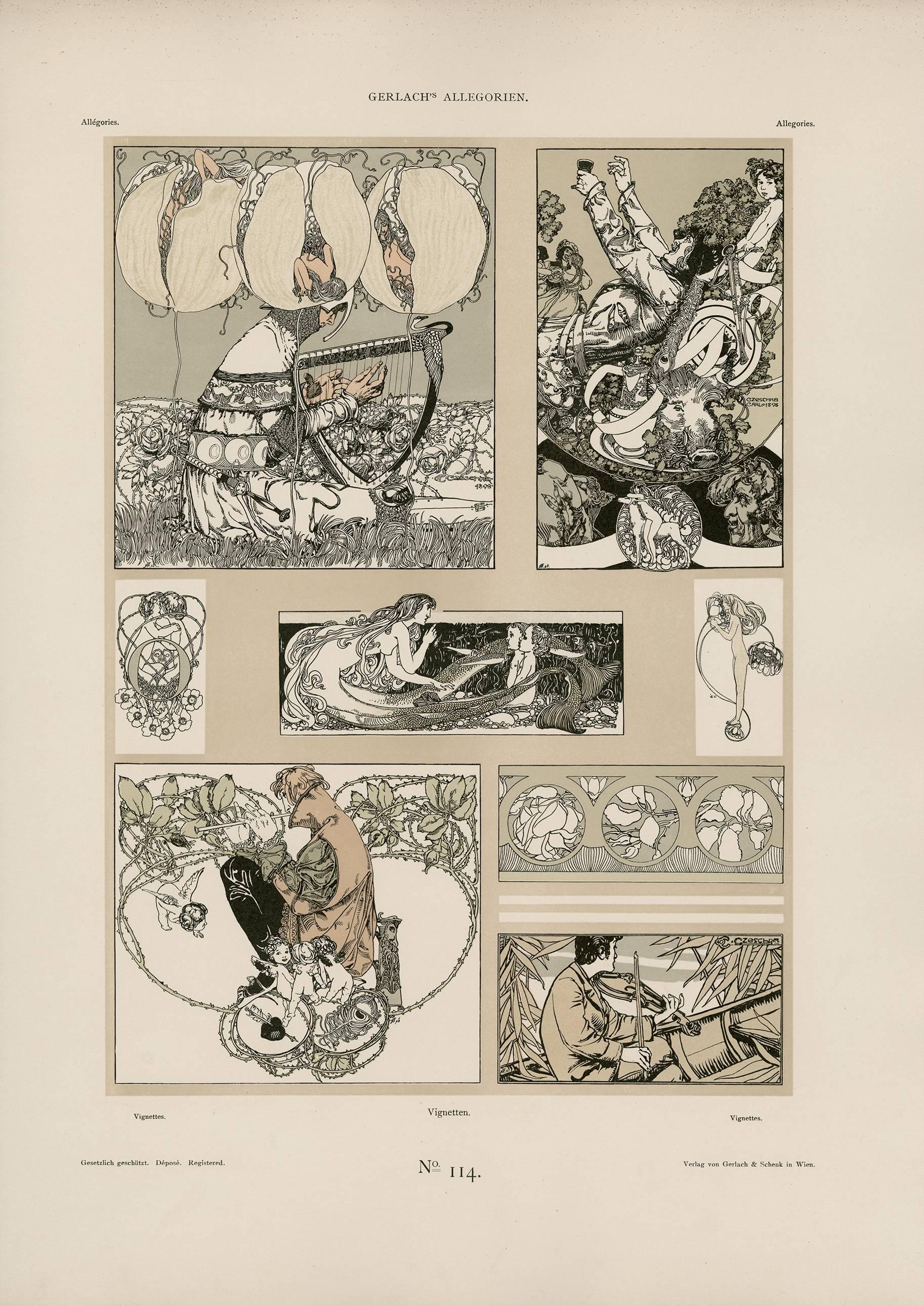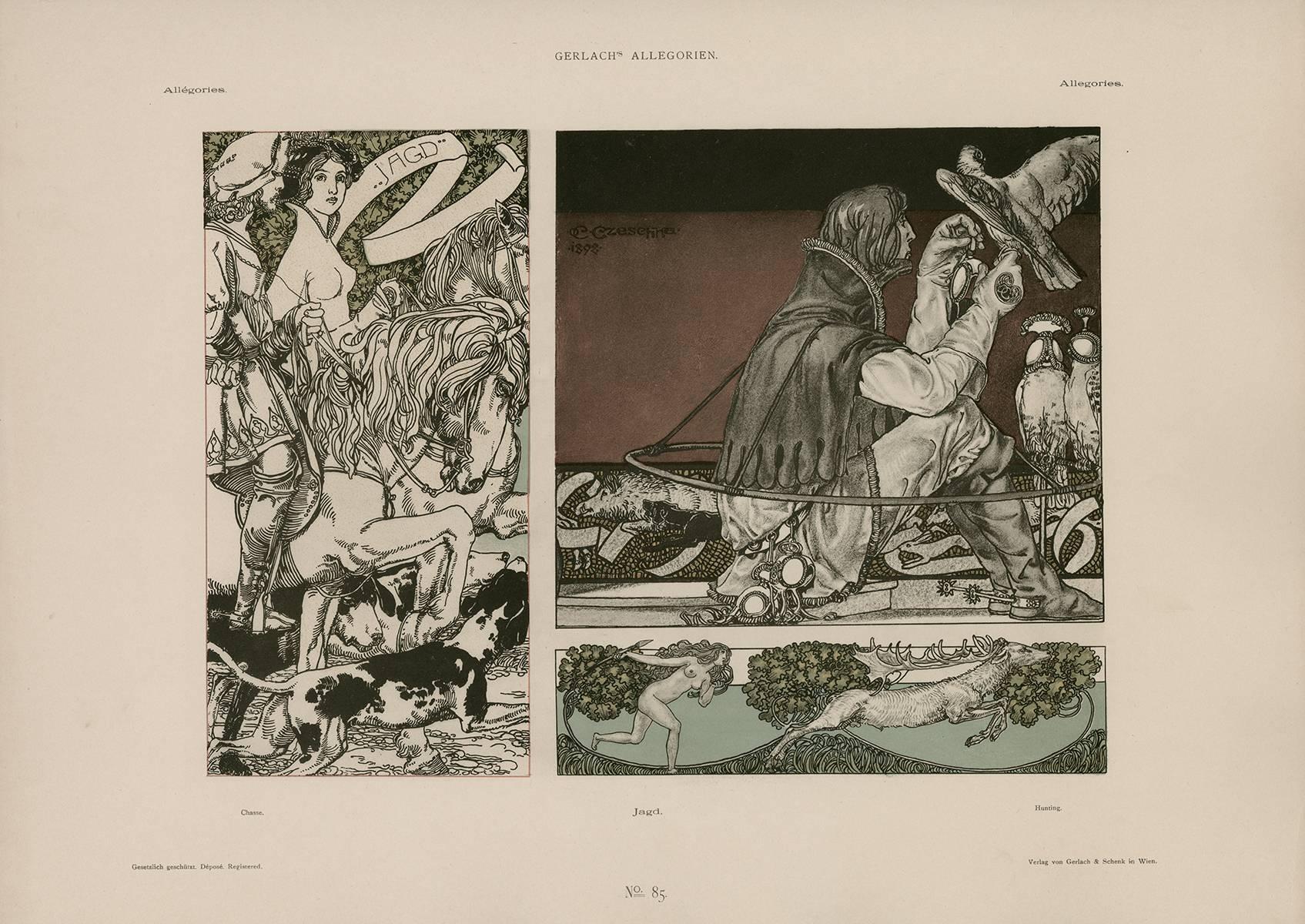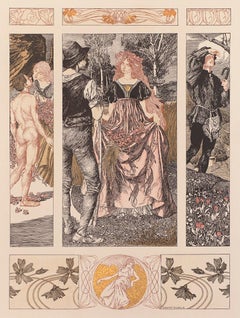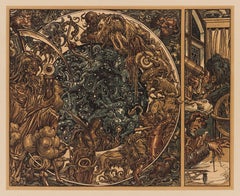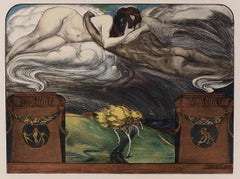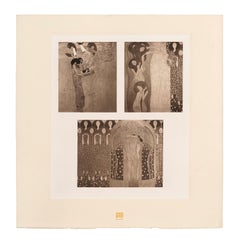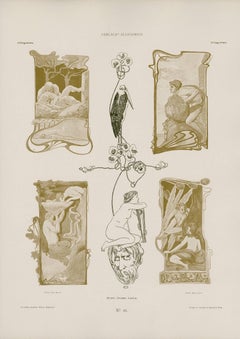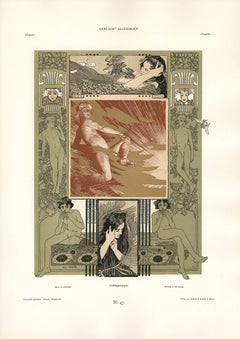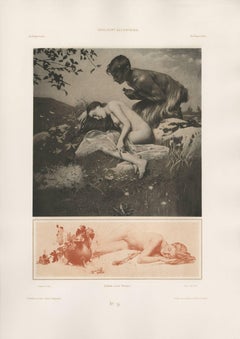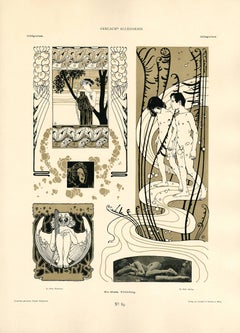Items Similar to The Thirst, Plate 52 from Gerlach's Allegorien, Vienna Secession lithograph
Video Loading
Want more images or videos?
Request additional images or videos from the seller
1 of 6
Wilhelm ListThe Thirst, Plate 52 from Gerlach's Allegorien, Vienna Secession lithograph1897
1897
$1,800
£1,401.42
€1,593.82
CA$2,589.25
A$2,844.75
CHF 1,486.68
MX$33,925.98
NOK 18,825.43
SEK 17,537.47
DKK 11,909.76
About the Item
Wilhelm List, a friend and follower of Gustav Klimt, was a founder and leading member of the Vienna Secession and contributor to its official magazine, Ver Sacrum. List’s plate ‘The Thirst’ for Gerlach’s Allegorien features a figure seated amidst flourishing grape vines, quenching her companion’s thirst with their juice.
Allegorien-Neue Folge was a serialized folio published in installments between 1895 and 1900. Martin Gerlach, its publisher, was inspired by the rise of modernist design in Vienna and selected those who were demonstrating a command of the style to contribute works to the series and selected the most exciting and innovative artists of the region to contribute works to the series, including Gustav Klimt, Koloman Moser, and Carl Otto Czeschka. Each plate explores a different theme or collection of topics, such as dance, astronomy, electricity, and graphic arts, which brought a new aesthetic of design to the traditional allegory genre.
Lithograph of Wilhelm Franz List’s Der Durst (The Thirst), published as Plate 52 in Gerlach’s Allegorien by Gerlach & Schenk, Vienna. This work is printed with dense, shimmering gold ink details throughout the main image and design element. The small-format lithographs created at this time were printed using rich, dense, lead inks.
This artwork arrives accompanied by a certificate of authenticity.
Notable museum collections featuring works by Wilhelm List include: Los Angeles County Museum of Art (LACMA); Musée des beaux-arts de Quimper, France; Aichi Prefectural Museum of Art, Japan
- Creator:Wilhelm List (1864 - 1918, Austrian)
- Creation Year:1897
- Dimensions:Height: 13.82 in (35.11 cm)Width: 17.88 in (45.42 cm)Depth: 0.2 in (5.08 mm)
- Medium:
- Movement & Style:
- Period:
- Condition:Exceptional condition commensurate with age.
- Gallery Location:Chicago, IL
- Reference Number:1stDibs: LU149327911172
About the Seller
5.0
Vetted Professional Seller
Every seller passes strict standards for authenticity and reliability
Established in 1999
1stDibs seller since 2021
42 sales on 1stDibs
- ShippingRetrieving quote...Shipping from: Chicago, IL
- Return Policy
More From This Seller
View AllSpring by Robert Engels, Medieval Art Nouveau lithograph with gold ink, 1897
By Robert Engels
Located in Chicago, IL
Allegorien-Neue Folge was a serialized folio published in installments between 1895 and 1900. Martin Gerlach, its publisher, was inspired by the rise of modernist design in Vienna an...
Category
1890s Vienna Secession Prints and Multiples
Materials
Lithograph
Astronomy, Plate 120 from Gerlach's Allegorien, Vienna Secession lithograph
By Hanus Schwaiger
Located in Chicago, IL
Allegorien-Neue Folge was a serialized publication of artworks by a group of Viennese artists and students beginning in 1897. Martin Gerlach, its publisher, was inspired by the new rise of modernist design in Vienna and selected those who were demonstrating a new command of the style to contribute works to the series, including Gustav Klimt, Koloman Moser, Carl Otto Czeschka, and Hanus Schwaiger. Each plate explores a different theme or collection of topics, such as dance, astronomy, electricity, and graphic arts, which brought a new aesthetic of design to the traditional allegory genre.
Stone lithograph of Hanus Schwaiger’s Astronomie, published as Plate 102 in Gerlach’s Allegorien...
Category
1890s Vienna Secession Prints and Multiples
Materials
Lithograph
Electricity by Ignatius Taschner, Art Nouveau lithograph, 1897
Located in Chicago, IL
Lithograph of Ignatius Taschner’s Electricity, published as Plate 95 in Gerlach’s Allegorien by Gerlach & Schenk, Vienna. This artwork arrives accompanied by a certificate of authenticity.
Allegorien-Neue Folge...
Category
1890s Art Nouveau Prints and Multiples
Materials
Lithograph
Beethoven Frieze (detail) by Gustav Klimt, Das Werk collotype, 1908-1912
By Gustav Klimt
Located in Chicago, IL
Original collotype created from a detail of Gustav Klimt’s Beethoven Frieze. Published and edited by Verlag H.O. Miethke and printed by k.k. Hof- und Staatsdruckerei, Vienna, in an e...
Category
Early 1900s Vienna Secession Prints and Multiples
Materials
Paper
Alphonse Mucha's "Figures Decoratives" 1905 Art Nouveau Lithograph, Plate 37
By Alphonse Mucha
Located in Chicago, IL
Plate 37 from Alphonse Mucha's Figures Decoratives, a folio of forty color lithographic plates published by Librairie centrale des beaux-arts in 1905.
Issued during a period of incr...
Category
Early 1900s Art Nouveau Prints and Multiples
Materials
Lithograph
Gonthier-Meymans by Henri Meunier, Art Nouveau Japon lithograph, 1897
By Henri Meunier
Located in Chicago, IL
Henri Meunier’s Gonthier-Meymans lithographic poster, published by Verlag von Gerhard Kühtmann in Dresden, 1897. While this poster was printed in multiple sizes and formats, this edi...
Category
1890s Art Nouveau Prints and Multiples
Materials
Lithograph
You May Also Like
Gerlach's Allegorien Plate #116: "Force, Thirst, Love" Lithograph
By Carl Otto Czeschka
Located in Palm Beach, FL
after Carl Otto Czeschka, (1878-1960), Austrian
A leading member of the Vienna Secession and later the Wiener Werkstätte (Viennese Workshop), Carl Otto Czeschka was a vital figu...
Category
1890s Vienna Secession Figurative Prints
Materials
Lithograph
Gerlach's Allegorien Plate #47: "Morning in the Spring" Lithograph
By Koloman Moser
Located in Palm Beach, FL
Koloman Moser
(1868 –1918), AUSTRIAN
Instead of applying his flair and art education solely to painting, Koloman Moser embodied the idea of Gesamt Kunstwerk (all-embracing art work) by designing architecture, furniture, jewelry, graphics, and tapestries meant to coordinate every detail of an environment. His work transcended the imitative decorative arts of earlier eras and helped to define Modernism for generations to come. Moser achieved a remarkable balance between intellectual structure (often geometric) and hedonistic luxury.
Collaborating with Gustav Klimt and Josef Hoffmann, the artist was an editor and active contributor to Ver Sacrum, (Sacred Spring), the journal of the Viennese Secession that was so prized for its aesthetics and high quality production that it was considered a work of art. The magazine featured drawings and designs in the Jugendstil style (Youth) along with literary contributions from distinguished writers from across Europe. It quickly disseminated both the spirit and the style of the Secession.
In 1903 Moser and Hoffmann founded and led the Wiener Werkstatte (Viennese Workshop) a collective of artisans that produced elegant decorative arts items, not as industrial prototypes but for the purpose of sale to the public. The plan, as idealistic then as now, was to elevate the lives of consumers by means of beautiful and useful interior surroundings.
Moser’s influence has endured throughout the century. His design sensibility is evident from the mid-century modern furniture of the 1950s and ‘60s to the psychedelic rock posters...
Category
1890s Vienna Secession Figurative Prints
Materials
Paper
Gerlach's Allegorien Plate #35: "Love & Wine" Lithograph
By Koloman Moser
Located in Palm Beach, FL
Koloman Moser
(1868 –1918), AUSTRIAN
Instead of applying his flair and art education solely to painting, Koloman Moser embodied the idea of Gesamt Kunstwerk (all-embracing art work) by designing architecture, furniture, jewelry, graphics, and tapestries meant to coordinate every detail of an environment. His work transcended the imitative decorative arts of earlier eras and helped to define Modernism for generations to come. Moser achieved a remarkable balance between intellectual structure (often geometric) and hedonistic luxury.
Collaborating with Gustav Klimt and Josef Hoffmann, the artist was an editor and active contributor to Ver Sacrum, (Sacred Spring), the journal of the Viennese Secession that was so prized for its aesthetics and high quality production that it was considered a work of art. The magazine featured drawings and designs in the Jugendstil style (Youth) along with literary contributions from distinguished writers from across Europe. It quickly disseminated both the spirit and the style of the Secession.
In 1903 Moser and Hoffmann founded and led the Wiener Werkstatte (Viennese Workshop) a collective of artisans that produced elegant decorative arts items, not as industrial prototypes but for the purpose of sale to the public. The plan, as idealistic then as now, was to elevate the lives of consumers by means of beautiful and useful interior surroundings.
Moser’s influence has endured throughout the century. His design sensibility is evident from the mid-century modern furniture of the 1950s and ‘60s to the psychedelic rock posters...
Category
1890s Vienna Secession Figurative Prints
Materials
Lithograph
Gerlach's Allegorien Plate #89: "Bookplate Spring" Lithograph
By Koloman Moser
Located in Palm Beach, FL
Koloman Moser
(1868 –1918), AUSTRIAN
Instead of applying his flair and art education solely to painting, Koloman Moser embodied the idea of Gesamt Kunstwerk (all-embracing art work) by designing architecture, furniture, jewelry, graphics, and tapestries meant to coordinate every detail of an environment. His work transcended the imitative decorative arts of earlier eras and helped to define Modernism for generations to come. Moser achieved a remarkable balance between intellectual structure (often geometric) and hedonistic luxury.
Collaborating with Gustav Klimt and Josef Hoffmann, the artist was an editor and active contributor to Ver Sacrum, (Sacred Spring), the journal of the Viennese Secession that was so prized for its aesthetics and high quality production that it was considered a work of art. The magazine featured drawings and designs in the Jugendstil style (Youth) along with literary contributions from distinguished writers from across Europe. It quickly disseminated both the spirit and the style of the Secession.
In 1903 Moser and Hoffmann founded and led the Wiener Werkstatte (Viennese Workshop) a collective of artisans that produced elegant decorative arts items, not as industrial prototypes but for the purpose of sale to the public. The plan, as idealistic then as now, was to elevate the lives of consumers by means of beautiful and useful interior surroundings.
Moser’s influence has endured throughout the century. His design sensibility is evident from the mid-century modern furniture of the 1950s and ‘60s to the psychedelic rock posters...
Category
1890s Vienna Secession Figurative Prints
Materials
Lithograph
Gerlach's Allegorien Plate #114: "Vignettes" Lithograph by Carl Otto Czeschka
By Carl Otto Czeschka
Located in Palm Beach, FL
after Carl Otto Czeschka, (1878-1960), Austrian
A leading member of the Vienna Secession and later the Wiener Werkstätte (Viennese Workshop), Carl Otto Czeschka was a vital figu...
Category
1890s Vienna Secession Figurative Prints
Materials
Lithograph
Gerlach's Allegorien Plate #85: "Hunting" Lithograph by Carl Otto Czeschka
By Carl Otto Czeschka
Located in Palm Beach, FL
after Carl Otto Czeschka, (1878-1960), Austrian
A leading member of the Vienna Secession and later the Wiener Werkstätte (Viennese Workshop), Carl Otto Czeschka was a vital figu...
Category
1890s Vienna Secession Figurative Prints
Materials
Lithograph
More Ways To Browse
Antique Vienna Plate
Vienna Art Plate
Tyler Stout
Uncle Sam Poster
Van Dyck Prints
Vintage Gladiolus
Vintage Silkscreen Posters
Vuillard Pastels
Yayoi Kusama Pumpkin Print
Adele Bloch Bauer
Adrian Piper
Andy Warhol Ladies
Andy Warhol Limited Editions
Andy Warhol Signed Lithograph
Bar Mitzvah
Bob Cato
Campari Print
Cindy Sherman Poster
